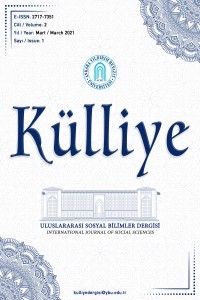Dünya Edebiyatında Feminist Hareketin Bir Yansıması Olarak “Kadın Gotiği”
Bu çalışmada, çağdaş edebiyat eleştirisinde kullanılan yenilikçi bir kavramı tanımlayan Kadın Gotiği genel hatlarıyla ele alınmakta; kadınların benlik farkındalığına vurgu yapan terimin tarihsel içeriği ortaya konulmaktadır. Kadın Gotiği türünün öne çıkan metinlerini toplumsal cinsiyet çalışmaları perspektifinden sunmayı amaçlayan makalenin ilk bölümü, erken dönem Gotik yazarlarını etkisi altına alan Aydınlanma Çağı eleştirisine ayrılmıştır. Bir sonraki bölümde dünya edebiyatında Kadın Gotiği’nin önde gelen temsilcileri ve tanınmış eserleri sunulmaktadır. Son olarak Gotik edebiyatın Rusya’da yayılmasında Kadın Gotiği’nin rolü incelenmekte ve türün Rus temsilcilerinden Teffi, Yelena Gan ve Nina Sadur’un yapıtlarından söz edilmektedir. Çalışmada, “kadınlar tarafından, kadınlara dair ve kadınlar için yazılan” edebiyat anlayışının bir ürünü olarak ortaya çıkan Kadın Gotiği türünün ilk örneklerinin, liberal feminizme özgü taleplerin dile getirildiği birer araç olarak kullanıldığı vurgulanmaktadır. Öte yandan, türün içeriğinin, kadın hareketinin beden ve kimlik siyaseti üzerindeki belirleyici rolünden etkilenerek geçirdiği dönüşüm ele alınmaktadır.
Anahtar Kelimeler:
Kadın gotiği, gotik edebiyat, kadın edebiyatı, feminizm, Aydınlanma eleştirisi
“Female Gothic” as a Reflection of Feminist Movement in World Literature
This article focuses on the Female Gothic, which allows to define an innovative concept used in modern literary criticism. The article reveals the historical content of the term that emphasizes the importance of the womens’ self-awareness. The purpose of the article is to provide a general description of the notable texts of the genre through the lens of gender studies. The first part of the article is devoted to philosophical criticism of the Age of Enlightenment, which influenced the early Gothic writers. The brightest representatives of Female Gothic in world literature and their most famous works are presented in the next part. And finally the last part examines the role of Female Gothic in the spread of Gothic literature in Russia, and also mentions the works of Russian representatives of the genre like Teffi, Elena Gan and Nina Sadur. The article emphasizes that the first examples of the Female Gothic, “written by women about women and for women”, were used as instruments that reflected the demands of liberal feminism. On the other hand, the article takes into account the contextual change of the genre, that was shaped by the defining role of the women's movement in the politics of body and identity.
Keywords:
female gothic, gothic literature, women's literature, feminism, critics of the Enlightenment,
___
Бронте, Эмили. (1988). Грозовой перевал. (пер. с англ. Н. Вольпин). Москва: Правда.Вацуро, Вадим Эразмович. (2002). Готический роман в России. Москва: Новое литературное обозрение.
Ган, Елена Андреевна. (1986). «Суд света». Дача на Петергофской дороге. Проза русских писательниц первой половины XIX века. Москва: Современник.
Грибанов, Алексей и Квашнин, Дмитрий. (2015). Русская готика: век двадцатый. Нетускнеющее серебро. Darker: онлайн журнал ужасов и мистики. https://darkermagazine. ru/page/russkaja-gotika-vek-dvadcatyj-netusknejushhee-serebro-2 [Дата обращения: 22.04.2021].
Достоевский, Федор Михайлович. (2008). Собрание сочинений: Подросток. Зимние заметки о летних впечатлениях. Вечный муж. Москва: Мир книги.
Новикова, Татьяна Леонидовна. (2012). Нина Садур и женский готический роман. Вестник Московского университета. Филология, (3), 36-51.
Садур, Нина. (2003). Злые девушки. Москва: Вагриус.
Тесцов, Сергей Валентинович. (2017). От готической архитектуры к готическому роману (К 300-летию со дня рождения Г. Уолпола). Сборник материалов Международной научно-практической конференции. 9 апреля 2017 г. Чебоксары: ЦНС «Интерактив плюс», 118-122.
Тэффи, Надежда Александровна. (1990). Юмористические рассказы. Москва: Художественная литература.
Тэффи, Надежда Александровна. (1999). Собрание сочинений. Т. 2. Москва: Лаком.
Хоркхаймер, Макс и Адорно, Теодор. (1997). Диалектика Просвещения. Философские фрагменты. (пер. с немец. М. Кузнецова). Москва и СПб: Медиум, Ювента.
Шелли, Мэри Уолстонкрафт. (2000). Франкенштейн, или Современный Прометей. (пер. с англ. З. Е. Александрова). СПб: Азбука.
Ayers, Carolyn Jursa. (1999). “Elena Gan and the Female Gothic in Russia”. The Gothic-fantastic in Nineteenth-century Russian Literature. Ed. Neil Cornwell. Amsterdam & Atlanta, GA: Rodopi. 171-187.
Brontë, Charlotte. (1864). Jane Eyre. NY: Carleton.
Eagleton, Terry. (2005). Myths of Power: A Marxist Study of the Brontës. Basingstoke: Palgrave Macmillan.
Gao, Haiyan. (2013). “Reflection on Feminism in Jane Eyre”. Theory and Practice in Language Studies, 3 (6), 926-931.
Gatens, Moira. (1996). Imaginary Bodies: Ethics, Power, and Corporeality. London & NY: Routledge.
Glimm, Adele. (2000). Elizabeth Blackwell: First Woman Doctor of Modern Times. NY: McGraw-Hill.
Hughes, William. (2013). Historical Dictionary of Gothic Literature. Lanham, Toronto & Plymouth: The Scarecrow Press.
Moers, Ellen. (1976). Literary Women: The Great Writers. New York: Doubleday.
Novikova, Tatyana Leonidovna. (2008). “Art of Darkness: Nina Sadur's Gothic Fictions”. Notes on Contemporary Literature, 38 (3), 9. https://www.semanticscholar.org/paper/Art-of-Darkness%3A-Nina-Sadur's-Gothic-Fictions-Novikov/a79fff7ce098be6950ab34f685e26700fca8ebec [Last accessed: 7.5.2021].
Riu, Carmen P. (2000). “Two Gothic Feminist Texts: Emily Brontë’s ‘Wuthering Heights’ and the Film ‘The Piano’ by Jane Campion”. Atlantis, 22 (1), 163-173.
Snodgrass, Mary Ellen. (2005). Encyclopedia of Gothic Literature. New York: Facts on File.
Wallace, Diana & Smith, Andrew. (2009). The Female Gothic: New Directions. Basingstoke, Hampshire: Palgrave Macmillan.
- Yayın Aralığı: Aylık
- Yayıncı: Ankara Yildirim Beyazit University
Sayıdaki Diğer Makaleler
Dünya Edebiyatında Feminist Hareketin Bir Yansıması Olarak “Kadın Gotiği”
Benliğin Tasavvuf ile Dönüşümü: Ayşe Şasa
Barış İnşası Kuram ve Uygulaması
KIRK YIL VE BİR ACI HİKÂYE ADLI ESERLERİ ÜZERİNDEN HALİT ZİYA UŞAKLIGİL’İN ÖLÜMLE TEMASI
DARÜLBEDAYİ’NİN KURULUŞUNDAKİ TARTIŞMALAR VE REŞAT NURİ GÜNTEKİN’İN KATKILARI
